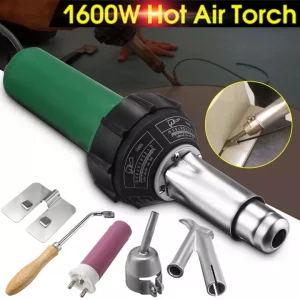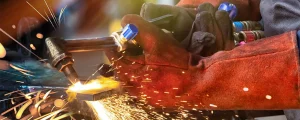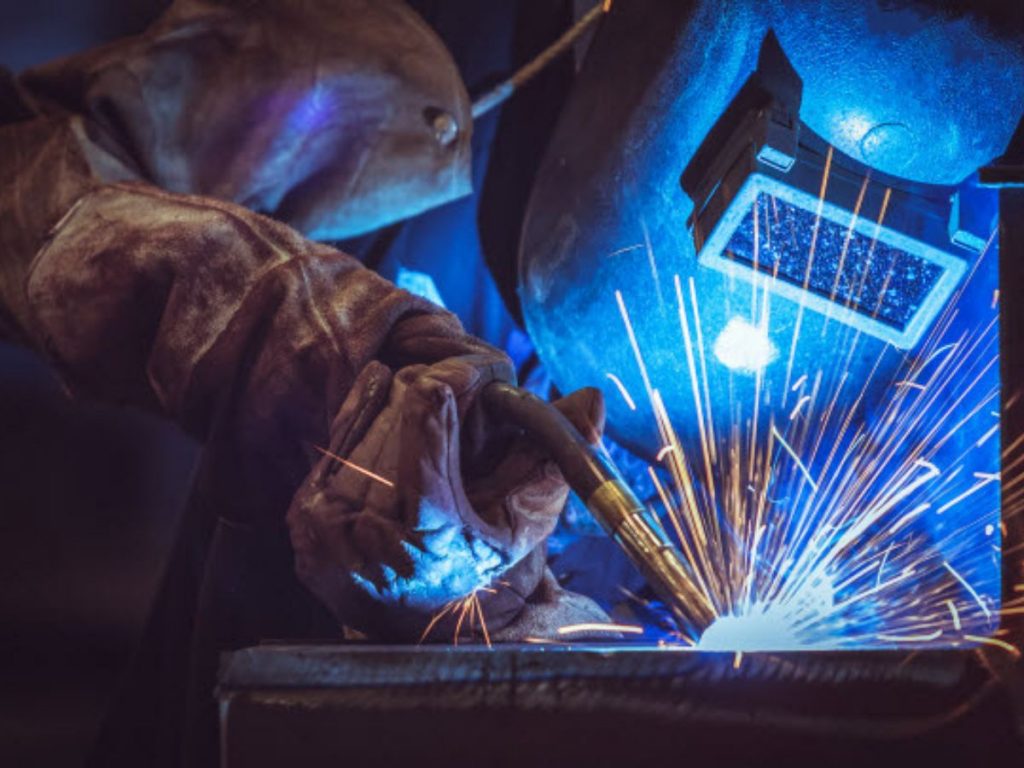A welding torch can be dangerous if the flame is too hot. Here’s how to tell if a welding torch is hot enough to burn your eyes. Basically, the flame will be applied to a piece of metal and held until a small puddle of molten metal is formed. The welder will then manipulate the torch so that the puddle moves toward the hottest metal.
How hot do welding torches get?
Welding torches are used to join pieces of metal together by welding. They use compressed oxygen and a fuel gas called acetylene. The gas has a garlic-like odor and produces an extremely hot flame – up to 10,832 degrees Fahrenheit. When welding, you should use a regulator to control the gas pressure.
The flame of a welding torch reaches melting point in a short amount of time. The flame then moves along the surface of the metal to join the two pieces. As the flame heats the metals, it creates sparks and a strong bond. It only takes a few seconds for the two pieces of metal to be joined together.
Welding torches have several types and use different methods for fusing metals. The primary application of welding torches is in metalworking, which includes auto manufacturers, ship builders, and many other industries utilizing heavy metals. They are also used in many repair applications, such as fixing machinery and fixing car frames.
Oxy-fuel welding is a popular welding method because of the high temperature of the flame. Oxy-acetylene welding is a process that uses a mixture of oxygen and acetylene to create a relatively hot flame. The flame temperature of an oxy-acetylene torch can vary from 2,100 degrees to 3,200 degrees. The flame’s temperature can be adjusted by adjusting the ratio of oxygen and acetylene.
How hot is the tip of a torch?
A welding torch’s tip is very hot. This is largely due to the oxygen flow rate. When the oxygen flow rate is too low, the flame is too thin and produces a ragged cut, while a higher flow rate means that the flame is too wide and wastes oxygen. To determine the appropriate flow rate, you must use a regulator. The regulator should match the orifice of the cutting tip.
The angle between the torch tip and the base metal is important to avoid the use of shielding gas. A 15-degree angle is usually recommended, but you can experiment with different angles. For example, if you hold the torch at 45 degrees, you’ll lose shielding gas coverage and create a larger puddle.
A welding torch’s tip can be as hot as 50,000 degrees Fahrenheit. The temperature of the welding arc is concentrated in the weld zone, which is why welders must take special precautions.

What is the average hot of welding torch?
The flame temperature of a welding torch varies according to the gas used. The typical flame temperature for acetylene, which is the fuel gas used for welding, is about 5730 degrees Fahrenheit. The amount of heat that it produces is also affected by the proportion of oxygen to acetylene. This gas can create oxidizing, carburizing, or neutral flames, depending on the concentration.
The primary place that welding torches are used is in the metalworking industry. This includes shipbuilders, automobile manufacturers, and other heavy metal industries. In addition, welders are used in a variety of repair capacities, such as fixing machinery and car frames. They are also used to create sculptures, such as those made from metal.
The temperature of a welding torch is a very important factor in the quality of the weld. An excessively hot flame will result in a bad weld. Overheated metal will stretch, break, and flatten. It is crucial to keep a constant speed when welding, and the torch should not be held in one place.
The temperature of a welding arc can reach thousands of degrees Fahrenheit. For a plasma welder, this temperature may even exceed fifty thousand degrees. While welding arcs are not as hot as the sun, they can be near enough to harm a welder’s eyes. For this reason, it is important to wear protective clothing when welding.
What to do when welding burns your eyes?
Welders must be careful when they work with a torch, since the light from the torch can burn the cornea and damage your eyes. If you think you’ve been exposed to UV light, contact a medical doctor as soon as possible. The doctor will perform a series of tests to determine the cause of the burn and to determine if there is any danger to the patient’s eye. He will examine the eyelids, pupil, and vision and use specialized equipment to check the surface of the eye. A numbing eyedrop and a painless dye (fluorescein) may be used to help with the examination. This dye will disappear when the eye tears normally.
Ice packs can be used to relieve the pain and irritation caused by welding burns. Ice packs can relax the nerves in the eye and reduce inflammation. Apply the ice pack for 5 minutes at a time, and repeat as necessary. This treatment is not recommended for long-term use, but can alleviate the itching and inflammation associated with the burning.
Using sunglasses to protect your eyes from UV light is important. If your welding torch produces enough UV light, it may cause a flash burn, or arc eye. These conditions are uncomfortable and can cause temporary or permanent blindness. You must consult a doctor if you develop these symptoms.

Safety Tips
Welding is dangerous work, and it is important to follow safety tips when using a welding torch. First, welders should keep their workspace clear of flammable materials. Make sure to place fire extinguishers and fire hoses nearby. Also, welders should cover any flammable materials they are working on with a sheet metal or fire-resistant blanket. They should also have a fire-watcher nearby to monitor for sparks. In addition, all welding equipment should be regularly inspected and maintained to ensure it is in good working condition. When performing urgent machinery welding repair, it is crucial to double-check that all safety measures are in place and that the area is free from any potential hazards. It’s also important for welders to wear the proper protective gear, including a welding helmet, gloves, and flame-resistant clothing, to minimize the risk of injury.
Using a welding torch involves exposing yourself to a variety of dangerous chemicals. Welding gases, UV rays, and molten metal are known to cause severe burns to the skin and eyes. As these hazards can occur very quickly, it is crucial to follow safety tips when using a welding torch.
Always wear protective clothing that protects you from ultraviolet rays and radiation. Wear flame-resistant cotton or leather. Avoid rolling up your clothing, which can expose you to molten metal and cause severe burns. Similarly, do not tuck your pants into boots. These precautions can save you a trip to the emergency room.
Always remember that welding on fuel containers is hazardous. Clean fuel containers before welding, and provide a fire watch for the area where you are working.
Benefits of using welding torch
A welding torch can be beneficial in many situations. It is a portable tool that can be carried anywhere and can provide consistent heat and electrical conductivity. Welding torches have a unique design that makes them less likely to be loose, increasing productivity and performance. In addition, they are easy to change out and come with a spare neck for replacement.
Welding torches can also be ergonomically designed to reduce the strain on a welder’s body. This allows for easier access to hard-to-reach welds and reduces fatigue. Welders are estimated to join metal every day, and they create various products across different industries.
Welders can use either a TIG or a MIG welding torch to weld metal. Both methods use the same process, but one type uses gas or oxygen. The difference lies in the materials that are welded. The first type, MIG welding, is typically used to weld metals. The second type, TIG welding, is similar to MIG welding but uses tungsten electrodes. TIG welding also reduces splatter because of a shield of gas.
A welding torch that has integrated extraction and source extraction is a much better option than other source extraction methods. It carries the welder around automatically, while other methods require a welder to manually reposition the extraction unit.
Conclusion
The flame from a welding torch is not designed to melt the metal, but to heat it up to an ignition temperature. The flame is inflated by blowing extra oxygen under high pressure down the third tube. This oxygen ignites the metal, turning it into molten oxide, which then travels through the workpiece. The flame has a specific diameter, or kerf, that’s ideal for welding. The flame’s size must be adjusted to match the thickness of the metal and joint design.
Oxy-propane torches are more commonly used for cutting scrap. Propane is cheaper than acetylene and can be used on larger sections. However, you should never use more than one seventh of a propane cylinder per hour. However, if you must use acetylene, make sure you have good ventilation and keep the flames below 1 atm (15 psi).

